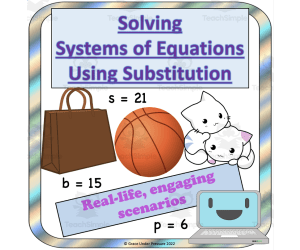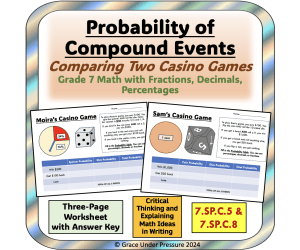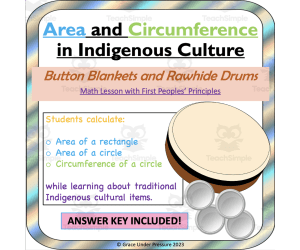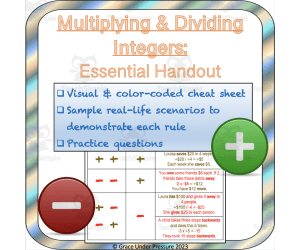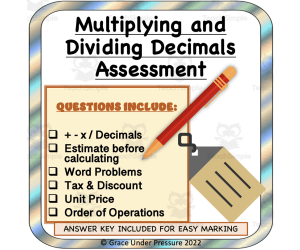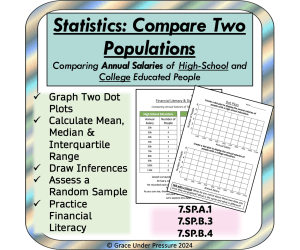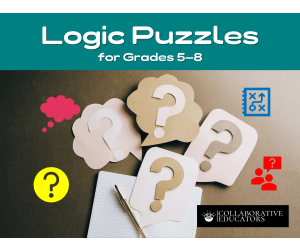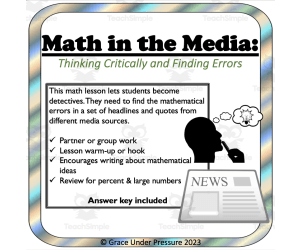2,745 products added recently
8th Grade Word Problems
Provide eighth graders with word problems that involve geometry, functions, and complex algebraic concepts. These worksheets bridge the gap to high school mathematics. Use them to ensure readiness and build confidence.
Scale Drawing Word Problems Digital and Printable
Math, Geometry, Measurements, Grade 7, 8, 9, Activities, Worksheets & Printables, Task Cards, Word Problems
Engage your learners with this Scale Drawing Word Problems Activity: Digital and Printable, and drive the stress out of teaching and learning! Be it digital or paper-and-pencil classrooms, this resource will work in engaging your students, saving your preparation time, and offering them effective self-paced learning. This activity is both instructive and engaging, with 20 real-world problems involving scale drawings, area, and perimeter. With the self-checking features, students get immediate feedback and are free to work at their own pace, coming to you only when they need help. Why You Will Love This Resource ✅ No Prep Required Spend less time planning! Everything you need is ready to go, whether you're teaching online or in person. ✅ Digital and Printable Options Digital versions for online learners that are interactive. Printable worksheets and task cards for hands-on practice. ✅ Self-Checking Tools for Independent Learning Students receive immediate feedback, which builds confidence and limits disruptions. Great for stations, homework, or independent study. ✅ Engaging and Fun Real-world problems keep students engaged. Focused on practical challenges to be solved with scale drawings, measurements, and geometric concepts. What's Included? ???? 20 Word Problems Practice making scale drawings using imperial and customary measurements. Find area and perimeter of rectangles and triangles. Printable Worksheets & Task Cards Great for classroom activities, group work, or homework assignments. ✔️ Complete Solutions Clear, detailed answers for easy reference by students and teachers. Perfect for Your Classroom Grade Levels: Ideal for grade levels learning about scale drawings and the basics of geometry. Flexible Use: Great for digital, hybrid, or traditional learning environments Independent Learning: Self-paced design promotes student accountability while minimizing disruptions. Why Teachers Love It This resource is designed to make teaching easier and learning more effective. The no-prep format saves you time, while the self-checking features keep students on track. With both digital and printable options, you can tailor the activity to fit your unique teaching needs.
Author Matemaths
Tags Pixel Art, Interactive Activity, Digital Learning, Matemaths, Task Cards, Printable, Digital, Word Problems, Scale Drawing
Math Journal: Experimental Probability with Two Independent Events
ELA, Math, Percentages, Fractions, Statistics, Writing, Grade 5, 6, 7, 8, 9, Worksheets & Printables, Word Problems, Activities
Math Journal: Experimental Probability with Two Independent Events This resource serves as a helpful teaching tool for educators focusing on the concepts of experimental probability and theoretical probability of two independent events in middle school mathematics. It offers an engaging math journal entry exercise that allows students to explain their mathematical thinking in pictures, numbers, diagrams, and words. How to Use: Students are given the following question: You have a six-sided die and a penny. If you roll the die twice and flip the penny twice, which is more likely: to get two sixes on the die or two heads from the penny? Explain your thinking using pictures, numbers, and words. Can you figure out the percentage chance of each event happening? Give students dice, coins, and mini whiteboards to work with so they can start to test out their ideas and theories. Encourage students to tackle the penny first as there are fewer results when flipping two coins. Suggest that students work together in pairs or small groups and use a table or chart to record the experimental options that could occur. You may want to start by teaching a mini-lesson about the probability of two independent events: that one multiplies the probability of each event to determine the probability of BOTH events. Grades to Use With This resource is ideal for use with students in grades 5-9 but can also be used as special education material or enrichment content for gifted children aged between grades 4-6. Finally, it could be used in a high school special education classroom. What's Included: This two page PDF is ready to print and go! If you enjoy this math journal entry, check out my bundle of 20 Middle School Math Journal Entries or my Math Journal Rubric for easy marking. Or, explore other probability items in my store.
Author Grace Under Pressure
Tags Math Journal, Experimental Probability, Two Independent Events, Middle School, Probability, Dice , Coins, Chance, Middle School Math, Fractions
Money Math Life Skills Worksheet: Reading Restaurant Menus Level 3
Special Resources, Creative Arts, Art, Life Studies, Social Emotional Learning (SEL), Special Education Needs (SEN), Life Skills, Math, Money, Grade 7, 8, 9, Worksheets & Printables, Word Problems, Activities, Worksheets
Money Math Life Skills Worksheet : Reading Restaurant Menus Level 3 This 192-question Special Education life skills activity teaches grade 7-9 students to calculate tips, apply sales tax, and determine total meal costs using six standard restaurant breakfast and lunch menus. Students will: - Calculate meal costs with 2, 3, and 4 menu items - Apply sales tax to meal costs - Calculate tips Use this printable worksheet one-on-one or in special education classes to develop essential real-world math and money management abilities. It includes step-by-step instructions, questions, answers, graphics, and ideas for implementation. Excellent for IEP goal setting and measuring progress in money math. Engage students with this highly interactive life skills activity!
Author Adulting Life Skills Resources
Tags Life Skills Money Math, Special Education Money Math, Independent Living Skills, IEP Goal-Oriented Skills, Community-Based Instruction, Adulting On The Spectrum, Social And Emotional Learning, Life Skills For Adults, Life Skills For Teens, Autism And Money Skills
Systems of Equations Word Problems Worksheet: Using Substitution
Math, Algebra, Grade 8, 9, 10, 11, Worksheets & Printables, Word Problems, Worksheets
This engaging math activity allows high school students in grades 8-11 to gain a realistic understanding of solving systems of equations (with two variables and even three variables) using the substitution method. Using real-life examples including shopping, basketball scores, and even YouTube videos, your students learn a simple algebraic method of solving a system of equations: the substitution method. They also gain practice writing simple equations with variables to represent real-life word problem scenarios. There is even a more challenging system of equations with three variables included for your students who can handle an extra challenge: this one is so satisfying once they figure out how to solve it! A step-by-step sample problem that you can use as a teaching aid and a complete answer key are also included so that this lesson requires no prep! Grades to Use With: This lesson is designed for students in grades 8-11 in regular middle or high school math classes. It may also be used with students in high school special education classes who are able to access some algebra topics. Standards: CCSS8.EE.C.8b Algebraically solve systems of equations with two equations and two variables. CCSS8.EE.C.8c Solve realistic and mathematical problems involving two linear equations with two variables. CCSSHSA-REI.C.6 Solve systems of linear equations exactly (focusing on pairs of linear equations with two variables). What's Included: A total of 5 pages in PDF Format: 3 page worksheet with step-by-step sample question 2 page answer key If you enjoy this math assignment, check out other real-world math activities in my store: Household Budget Project: Taxes, Insurance, Loans, Groceries, and More! Decimal Operations Assessment: Add, Subtract, Multiply, and Divide Financial Literacy: Vacation Math Project Two Step Equations Worksheet: Real-World Two Step Equations Exponent Board Game: A Great Way to Practice Using Exponents Algebra: Modelling Equations Visual Balance Scale Worksheet
Author Grace Under Pressure
Tags Systems Of Equations, Algebra, Solving Equations, Real-life Equations, Substitution, Substitution Method, Algebra Substitution, Systems Of Equations Word Problems, Systems Of Equations Worksheet
Probability Word Problems Middle School Probability of Compound Events
Math, Statistics, Fractions, Decimals, Percentages, Grade 6, 7, 8, Worksheets & Printables, Word Problems, Worksheets
This middle school (grades 6-8) probability lesson and worksheet has three parts to help your class understand the probability of compound events (2 events that both occur but do not affect one another) and how to write probabilities as decimals and percentages. How it Works: There are two "casino games" presented. Each has two steps and specific rules. 1) Students first determine the theoretical probability (in fractions, decimals, or percents) of the casino game that has a spinner and a die and three different outcomes. 2) Students next determine the theoretical probability (in fractions, decimals or percents) of the casino game that has a penny and a die and three different outcomes. 3) Finally, students will compare the two games and pick which game they would choose to play using their math calculations as justification. Students can use fractions, decimals, or percents to figure out the theoretical probabilities from these two games. They will notice that all the outcomes in one game will always add to 1.00 or 100% This lesson is specifically created to target 7th Grade Statistics Learning Outcomes 7.SP.C.5 and 7.SP.C.8 What's Included: 5 Page PDF- Ready to Print and Use! - Teacher Instructions - 3-Page Student Worksheet with 2 Casino Games, Calculation Tables, and Written Reflection - COMPLETE ANSWER KEY INCLUDED If you like this activity, check out other probability options in my store! Middle School Math Stations or Centers for Statistics and Probability: Grades 5-8 These 5 math stations are a great way to help your students prepare for a unit test. They involve statistics and probability including working with dice, finding mode, median and mean, and creating simple graphs. Theoretical and Experimental Probability: Hands-On Math Task with Fractions and Percentages Here's a super low-prep probability experiment you can perform in your classroom, and easily tie into percentage math skills as well!
Author Grace Under Pressure
Tags Probability Word Problems, Probability Worksheet, Probability Of Compound Events, Probability, Compound Events, Middle School Probability, Fractions, Decimals
Circumference and Area of Circles (with First Peoples' Principles)
Social Studies, First Peoples (Native), Math, Geometry, Measurements, Grade 6, 7, 8, Worksheets & Printables, Word Problems, Worksheets
Circumference and Area of Circles with First Peoples' Principles is a teaching resource that combines math education with a basic introduction to two cultural traditions from indigenous groups. It is suitable for middle grades students in 6th to 8th grades. This lesson provides a practical application of geometry by instructing students on how to calculate the areas of rectangles as well as the area and circumference of circles. The lesson plan blends hands-on activities with relevant mathematics concepts, helping students to understand math theory through real-life tasks. 1) Students learn what a button blanket is and its cultural significance. They measure the area of a "blanket" and calculate the area of the "buttons." Then, they cut out the buttons and glue them on the blanket in a design. Finally, they calculate the area of the blanket that is not covered by the buttons. 2) Students learn what a drum is and its cultural significance. They calculate the circumference of the "drum." Then they determine the area and circumference of a piece of rawhide that would be needed to overhang and cover the drum. This flexible lesson can be used in whole-class sessions to guide every student step by step. It may also serve as a resource for small group work or homework assignments, promoting independent problem-solving skills outside school hours. Grades to Use With: This product is specifically designed to align with the British Columbia Mathematics 7 curriculum requirements, but it can fit into any learning environment studying circle areas & perimeters - ranging from middle school math classes, high school social studies lessons, or high school special education. The worksheets also help meet CCSSMP1 standards. What's included: An easy-to-follow four-page PDF including two student worksheets. An answer key for teachers to accurately assess student progress through each exercise. If you enjoy this math activity , check out many others in my store: Grace Under Pressure
Author Grace Under Pressure
Tags Circles, Geometry, Indigenous Culture, Area, Circumference, Radius, Diameter, Button Blanket, Drum, Area Of Circle
Percent Word Problems: Calculating Taxes, Tips, Sale Prices Worksheets
Special Resources, Life Studies, Life Skills, Math, Percentages, Decimals, Money, Fractions, Finance, Home Economics, Grade 6, 7, 8, 9, Worksheets & Printables, Word Problems, Worksheets
Percent Math Lesson: Calculating Taxes, Tips, and Sale Prices Here's a ready-to-go lesson for your middle school math unit on percentages. It encourages students to use multiple methods and mental math when calculating the tax, tip, or sale price for everyday transactions. This is one of the times you can easily say to your students, "You will use this math regularly in your life!" How to Use: Start with the handout, which goes through three simple methods for calculating percentages. Benchmark: An easy calculation strategy using familiar percentages like 1%, 10%, and 50%. Decimals: Calculating involves multiplying the amount by its matching decimal form percentage. Fractions: Division based on fraction equivalents is used for identifying certain percentage amounts. Tell your students that certain methods work best for certain situations. For example, the fraction method is great for 50% or 25% off. The benchmark method is easy when calculating a 10% tip. The decimal method works great for calculating 12% tax. Next, students have six real world math problems to tackle involving taxes, tips, and sale prices. They can use any of the strategies to solve any of the problems- they should choose the one that is the easiest to use for each scenario! Students can work individually or in pairs or small groups collaboratively. Grades to Use With: This lesson is perfect for grade 7 classes that are working on Proportional Relationships to solve multistep problems. It could also be used for enrichment in grade 6 or for a review and lesson about multiple strategies in grades 8 and 9. Finally, it could be used in high school special education classrooms. What's Included: Ready-to-print 5 Page PDF with a title page, handout, 2 pages of practice questions, and a complete answer key! If you like this percentage activity, check out others in my store: Math Stations: Percent, Decimals and Fractions Visual Math: Percentages, Decimals, Ratios and Fractions Posters Grocery Store Shopping: Price Comparisons
Author Grace Under Pressure
Tags Percent Calculations, Real-world Math, Percentages, Financial Literacy, Mental Math, Fractions, Decimals, Budget, Percent, Percent Word Problems
Math Practice Simplified L - Pre-Algebra
Math, Algebra, Grade 6, 7, 8, Worksheets & Printables, Word Problems, Worksheets
This mathematics-based resource is designed for grades 6-8. It’s imperative for students to have a strong foundation in basic math skills. This resource provides real-world activities to help students practice with signed numbers, expressions with exponents, square numbers and roots. Use this resource as a building block to higher mathematics. The first part of this resource focuses on integers. Rational and irrational numbers follow. This resource is perfect to prepare students to succeed on standardized tests . An answer key is included. Aligned to National Council of Teachers of Mathematics (NCTM) Standards.
Author Classroom Complete Press
Tags Math, Mathematics, Integers, Word Problems, Rational Numbers, Exponents, Square Root, Middle, Drills, Answer Key
Math Practice Simplified I - Money & Measurement
Math, Money, Measurements, Grade 5, 6, 7, 8, Worksheets & Printables, Word Problems, Worksheets
This mathematics-based resource is designed for grades 5-8. It’s imperative for students to have a strong foundation in basic math skills. This resource provides activities to help students understand everyday math basics through money and measurement. Students will add currency in the form of coins and determine how much change they will get back. Students will then move on to more advanced concepts, like budgeting, saving and borrowing money. This resource is perfect to prepare students to succeed on standardized tests . An answer key is included. Aligned to National Council of Teachers of Mathematics (NCTM) Standards.
Author Classroom Complete Press
Tags Math, Mathematics, Money, Measurement, Time, Temperature, Percentages, Decimals, Middle, Answer Key
Independent & Dependent Variables in Grade 6 Math: Hockey Math
Math, Algebra, Graphing, Grade 6, 7, 8, Worksheets & Printables, Word Problems, Worksheets
Here's a ready-to-go lesson to help show your students how learning about independent and dependent variables in grade 6 math can be helpful in the real world! This lesson is all about a hockey game and the mathematical relationships that can be found there. Students are given 4 scenarios about making ice, letting in fans, collecting money for 50/50 tickets, and the profits the arena makes. For each situation, they have to complete a table of values with missing entries, graph the relationship on the provided graph (labels and scales are already filled in), create an equation with the two provided variables, and answer one or two questions. The questions increase in difficulty throughout the assignment. You could use this lesson in several ways. After teaching your students the basic vocabulary and concepts from your math program, you could cut the four scenarios up and use them as task cards or stations. Or, you could assign one problem each to small groups. Or, you could give each student the entire double-sided worksheet. This could even be used as an assessment ! What's included: 4 Page PDF: Title and Instruction Page 2 Pages of Student Questions Complete Answer Key Grades to Use With: This lesson is designed for students in 6th Grade who are mastering the standard 6EE.C.9. However, it could also be a great review for students in 7th or 8th grades or it could be used in high school special education classes. If you enjoy this product, check out other 6th grade algebra activities in my store: Pre-Algebra Problem: The Wave Pool with Expressions, Tables, and Graphs Algebra: Modelling Equations: Visual Balance Scale Worksheet Exponent Board Game Or if you want more math games, check out some others in my store: Credit Score Board Game: Credit Cards, Loans, Mortgages and More: Personal Financial Literacy Bank Account Board Game: A Fun Financial Literacy Lesson for Addition, Subtraction or Integer Practice
Author Grace Under Pressure
Tags Independent Variable, Dependent Variable, Systems Of Equations, Graphing, Algebra, Equations, Variables, Tables, Linear Relationships, Real World Math
Financial Literacy: Compound Interest
Life Studies, Math, Decimals, Money, Finance, Home Economics, Business, Grade 8, 9, 10, 11, 12, Worksheets & Printables, Word Problems, Activities
This high school financial literacy lesson will show students why compound interest is so helpful to investors! The first page walks students through how to calculate compound interest step-by-step (year-by-year). Students need a basic understanding of writing percent as a decimal and multiplying to find the "percent of" a number. Students will be given an initial investment and a yearly interest rate. Each student in the class can have different values so they have to do their own work and so comparisons can be made. This allows for easy differentiation as well- give students who are struggling an easier interest rate (10%, 1%) and students who need a challenge a trickier one (6%, 4.5%) Students carefully calculate the amount of compound interest they would earn over ten years. They check their work using the compound interest formula. Then they can use the formula to calculate compound interest for longer periods of time. Your class can compare their results. I would recommend having a class discussion (prompt questions are included). Make sure to point out how compound interest is great for investing and saving and terrible for borrowing money. It works against you when you have a loan. Finally, students reflect on their learning by writing a paragraph after the lesson, and hopefully leave class wanting to start a saving account! This step-by-step lesson clearly shows students how compound interest works. They get practice doing calculations with precents written as decimals, exponents, and order of operations. It is the kind of math lesson that will stay with students long after the year is complete! Also check out my Financial Literacy Interest Rates: Lending and Borrowing Money Lesson!
Author Grace Under Pressure
Tags Financial Literacy, Compound Interest, Investment, Yearly Interest, Money, Personal Finance, Interest, Loans, Budget, Percent, Compound Interest Project, Compound Interest Lesson
Percent and Decimal Word Problems: Property Taxes Life Skills
Life Studies, Home Economics, Finance, Math, Decimals, Percentages, Special Resources, Life Skills, Grade 7, 8, 9, 10, 11, 12, Worksheets & Printables, Worksheets, Word Problems
Property Taxes: What they are, rates around the world, what they are used for, and how to calculate them! A great way to practice percent to decimal conversions, decimal operations, and rate and ratio learning! This two-page life skills and math worksheet is a quick and easy personal financial literacy activity for your middle or high school students. The Handout portion introduces your students to: Important vocabulary and definitions: property tax and a home’s assessed value. A variety of global property tax rates (ranging from 0.08% – 2.64%) in locations in the United States, Canada, and even Europe. A prompt about why rates vary (lower rates where property is expensive and higher rates where property is cheaper) is also included. What the money collected from property tax revenues is used for: from schools to sewers and roads to emergency services including fire fighters. The Worksheet portion has real-world math practice for your class: Students are taught how they can calculate an annual property tax amount using percentages converted to decimals. First, they practice converting between percents and decimals. Then, they multiply a home's assessed value by the property tax percentage (written as a decimal) in the municipality. 10 practice math questions are included for your students to work on. Finally, they will research the local property tax rate in their area: great real-life learning! A COMPLETE ANSWER KEY INCLUDED- so there is no guesswork when marking! Grades to Use With: This lesson is designed for any students in grades 7-12 who understand percent to decimal conversions, ratios and rates, and decimal operations (specifically multiplying a large number by a decimal). It could be used in high school family and consumer science class, business or economics, applied math, or even life skills classes. If you enjoy this lesson, check out others in my store: Income Tax Sales Tax Capital Gains Tax
Author Grace Under Pressure
Tags Percent Word Problems, Decimal Word Problems, Taxes, Property Tax, Family Consumer Sciences, Financial Literacy, Life Skills, Personal Finance, Home Economics, Percent Worksheet
Multiplying and Dividing Integers: Essential Handout/Cheat Sheet
Math, Number Lines, Multiplication and Division, Division, Numbers, Multiplication, Grade 5, 6, 7, 8, Worksheets & Printables, Word Problems, Worksheets
Do you need a single cheat sheet or succinct handout for your multiplying and dividing integers unit? This page has it all in one place: perfect for your students to refer back to again and again throughout multiple lessons. How to Use: Use this handout at the beginning of your unit to introduce the ideas behind the integer rules for multiplication and division. Have your students complete the sample questions as a quick assessment or homework task. Remind your students to refer back to this sheet when they are unsure about integer rules. Even allow some (or all) of your students to use it as a reminder/aid during the unit test! Three Parts: - Visual & color-coded cheat sheet - Sample real-life scenarios to demonstrate each rule (even why negative times negative is a positive!) [For example: You owe some friends $6 each. If 2 friends take those debts away: -2 x -$6 = +$12 You have $12 more.] - 15 Practice questions If you enjoy this product, check out my Adding and Subtracting Integers Math Stations! Grades to Use With: This handout is perfect for the middle grades (5-9) when you are introducing integer rules. It could also be useful in a high school special education classroom. What's Included: 2 Page PDF: Title Page and One-Page Student Handout and Worksheet Standards: CCSS6.NS.C.5 Understand that positive and negative numbers are used together to describe quantities having opposite directions or values (e.g., temperature above/below zero, elevation above/below sea level, credits/debits, positive/negative electric charge); use positive and negative numbers to represent quantities in real-world contexts, explaining the meaning of 0 in each situation. CCSS7.NS.A.2c Apply properties of operations as strategies to multiply and divide rational numbers. CCSS7.NS.A.3 Solve real-world and mathematical problems involving the four operations with rational numbers. Check out my store Grace Under Pressure for dozens more math ideas!
Author Grace Under Pressure
Tags Integers, Multiplying Integers, Dividing Integers, Middle School Math, Cheat Sheet, Handout, Math Practice, Mutiplication, Division, Dividing Integers Worksheet, Division Cheat Sheet
Financial Literacy: My Party Budget- Decimals and Percentages Application
Life Studies, Finance, Home Economics, Math, Percentages, Decimals, Grade 5, 6, 7, 8, Worksheets & Printables, Word Problems, Activities, Projects
Financial Literacy: My Party Budget- Decimals and Percentages Application Unlock mathematics’ real-world influence with this practical math project for students in grades 5-8. This tool allows students to sharpen their intermediate math skills, particularly applying percentage calculations and decimal operations to manage a budget consciously - a vital lesson in financial literacy. This versatile resource is ideal for grades 5 to 8 classrooms as well as high school special education environments where budgeting practice complements life skills training. How to Use: Give each student a party budget. You can choose to give everyone the same budget, OR this is a great way to differentiate. Give students with emerging understanding a budget of $100 (which is easy to work with) and give students who need a challenge a budget such as $240, which will result in more complex calculations. This will also stimulate discussions about budgeting in general and the challenge of planning with less money. Students need to partition their hypothetical party budget across varied cost categories like food, decorations and entertainment by employing basic percent in decimal form and understanding addition and multiplication of decimals. For example, they might decide to spend 50% of their budget on food because that is their favourite part of a party. They will calculate 50% of their total budget. This skill application brings relevance to numbers through experiential learning. You can decide if students should complete calculations by hand or if using a calculator is allowed. Also, a complete sample answer key is included that you can show to your students to demonstrate the task. Finally, students complete shopping research and choose items online or in store flyers. This fosters strategic thinking when managing limited resources. You can have a discussion about making tradeoffs (for example, choosing frozen pizza instead of fresh to have extra money for a party activity OR inviting fewer guests to have more money for party favours per person). What's Included: A total of 8 pages in PDF Format Title Page Teacher Instructions 3 Page Student Worksheets 3 Page Sample Answer Key
Author Grace Under Pressure
Tags Financial Literacy, Decimals, Percentages, Budgeting, Math Application, Budget, Real World Math, Math Project, Applied Math, Party Project
Financial Literacy: Financial Trade-offs
Special Resources, Life Studies, Life Skills, Finance, Home Economics, Math, Money, Grade 7, 8, 9, 10, 11, 12, Worksheets & Printables, Word Problems, Activities
Financial Literacy: Financial Trade-offs Here’s a quick and simple way to include some easy financial literacy learning into your middle, high school, or special education class. These 8 prompts describe realistic financial scenarios about work, housing expenses, post-secondary education, cars, retirement planning, and wedding costs. Use them as debate topics, research prompts, or a simple whole class discussion (ideal for those extra few minutes you often end up with before the end of class). Only simple math skills and basic financial vocabulary are needed to understand these topics. How to Use: Start by explaining the basic premise to your students: Often people can feel stuck in their life due to a financial issue. However, by making a few financial trade-offs, there is usually a different way to deal with issues. Here are eight real life scenarios that many people deal with. Discuss them with your peers, have a debate, make a list of pros and cons! Realize that you always have more options if you can think critically and creatively. Main Goal: The main goal of these prompts is to drive home the importance of understanding trade-offs in goal setting and financial planning. Each topic presents itself as a relatable real-life scenario offering two distinctive choices involving critical thinking and decision-making. There is no "right" answer: just the right answer for your situation. Grades to Use With: These prompts could work in a middle or high school math class, a personal planning or career and education class, or a high school special education classroom. They could even be used in adult education scenarios. What's Included: A total of 10 pages in PDF: Title Page, Instruction Page and 8 trade-off situations If you enjoy this financial literacy product, please check out some of my other options in my store: FIRE: Financial Independence Retire Early Compound Interest: Hook Students on Financial Literacy Net Worth: Assets - Liabilities = Equity
Author Grace Under Pressure
Tags Financial Literacy, Trade-offs, Critical Thinking, Budget, Money, Life Skills, Real World Math, Finance, Planning, Personal Finance
Decimal Operations Assessment: Add, Subtract, Multiply, Divide
Math, Addition and Subtraction, Addition, Decimals, Multiplication and Division, Multiplication, Division, Subtraction, Grade 5, 6, 7, 8, Worksheets & Printables, Word Problems, Teacher Tools, Assessments
Decimal Operations Assessment : Add, Subtract, Multiply, Divide (with answer key) Do you need a quick and valid assessment for your decimal operations unit? Do you want to encourage your students to estimate before they calculate? Here is the math quiz for you! This 2-page decimal operations math quiz assesses the following topics Addition of decimals Subtraction of decimals Multiplication of decimals Division of decimals How to Use: The first page requires students not only to complete computations, but also to estimate their solutions before starting out. Half of the marks are given for successful estimations. This encourages students to develop estimation skills which can greatly help in identifying potential calculation errors. The second page contains word problems (worth 10 marks) that increase in complexity. These cover real-world scenarios such as unit price computation, tax calculations, evaluating sale prices and dealing with multiple operations simultaneously. These word problems aim to assess deeper levels of comprehension and application of decimal operation skills. What's Included: 5 Page PDF ready to print! Teacher Instructions 2 page decimal operations quiz 2 page complete answer key for easy marking Grades to Use With: This math quiz is designed for students in grades 5-8 who are first learning about decimal operations or reviewing this skill. The word problems also tie in with grade 6 learning standards about unit rates. This activity could also be used in high school special education classes. If you enjoy this applied math activity, check out others in my store: Grocery Game: Estimating, Adding, Multiplying Decimals Grocery Shopping Price Comparisons: Financial Literacy and Money Math Wave Pool Problem: Pre-Algebra Skills: Expressions, Tables, and Graphs: Real-Life Application Butter Tart Recipe Activity: Multiplication and Addition of Mixed Numbers and Improper Fractions Gingerbread Math: Decimals, Fractions, and Percentages Using Tenths Equivalent Fractions Practice in a set of 5 Stations or Centers
Author Grace Under Pressure
Tags Decimal Operations, Assessment, Problem Solving, Estimating, Multiplying Decimals, Adding Decimals, Math Quiz, Decimal Quiz, Decimal Operations Quiz, Unit Rate
Statistics Word Problems: Compare Two Data Sets of Annual Salaries
Math, Graphing, Measurements, Statistics, Grade 6, 7, 8, Worksheets & Printables, Worksheets, Word Problems
This middle school math lesson allows your students in grades 6-8 to apply the statistical skills they have been learning in class to a real-world financial literacy scenario: the annual salaries of workers who have a college degree compared to those who do not have one. It is a real world math activity that includes five worksheets all ready to go! Your students will: - Make two dot plots to display two data sets (that are included with the lesson): wages for people with a college degree and those without - Share observations about the distribution of data in each set - Calculate the mean, median and interquartile range for each data set - Draw inferences about whether there is an effect of a college education on someone's annual salary - Consider if the sample that was used is representative This lesson was designed to specifically address 7th Grade Common Core Math Standards for the Statistics and Probability strand: 7.SP.A.1 7.SP.B.3 7.SP.B.4 What's Included: 7 Page PDF- Ready to Print and Use! - Title Page with Teacher Instructions - Student Handout that has Two Data Sets (with 20 items each) - Dot Plot Worksheet (for students to graph and compare two dot plots) - 2-Page Measures of Central Tendency and Variation Worksheet - Reflection Worksheet - Answer Key If you enjoy this statistics lesson, check out other fun options in my store: Middle School Math Stations or Centers for Statistics and Probability: 5 Math Centers that are a great way to prepare for a unit test! Create Dot Plots and Histograms: 6th Grade Statistics and Graphing Practice: Students create and carry out their own survey and then graph it two ways! Identifying and Writing Statistical Questions for 6th Grade Math: Help your students learn ways to collect data and try it out!
Author Grace Under Pressure
Tags Statistics, Compare Data Sets, Financial Literacy, Dot Plots, Statistics Word Problems, Compare Data Distributions, Mean, Median, Interquartile Range, Graphing Data
Math Project: Create your Dream Store: Decimal Calculations and Budgeting
Life Studies, Math, Addition and Subtraction, Addition, Decimals, Money, Finance, Business, Career, Grade 5, 6, 7, 8, Worksheets & Printables, Word Problems, Activities, Projects
This is an engaging math project that lets students apply math skills to a realistic situation: opening their own store! Grades to Use With: This project is perfect to use with your middle grades students in grades 5-8. It could also be a great addition to a high school life skills class studying finance, business, or careers. How to Use: Each of your students has won $2,000,000 in the lottery, and they are going to use it to open their very own store! They create a budget for a new business venture by considering the costs to rent a commercial storefront in your area, pay employees, and buy all of the supplies and stock they will need. They can do research on the internet to find out the prices of rental properties and the supplies they will need. They can do decimal calculations by hand or with a calculator. This will include adding decimals and multiplying decimals. Extension: Students who finish early can create an advertisement to attract customers to their new store. You could even have a day where each student presents their unique store idea to the class. Standards: CCSS5.NBT.B.7 Add, subtract, multiply, and divide decimals to hundredths, using concrete models or drawings and strategies based on place value, properties of operations, and/or the relationship between addition and subtraction; relate the strategy to a written method and explain the reasoning used. CCSS7.NS.A.3 Solve real-world and mathematical problems involving the four operations with rational numbers. If you enjoy this math project , check out some other options in my store: Math in the Real World: Personal Math Research Project for STEM, Enrichment, or Early Finishers Financial Literacy: Household Budget Project: Taxes, Insurance, Loans, Rent, Groceries and More!
Author Grace Under Pressure
Tags Math Project, Store Design, Budget, Decimal Calculations, Group Work, Financial Literacy, Applied Math, Money, Business, Project, Budgeting Project For Highschool Students
Percent Word Problems: Tipping & Gratuities- Real World Math Worksheet
Life Studies, Home Economics, Special Resources, Life Skills, Math, Multiplication, Multiplication and Division, Percentages, Money, Grade 6, 7, 8, 9, Worksheets & Printables, Word Problems, Teacher Tools, Lesson Plans
Tipping is becoming more and more common and the amount you are expected to tip is increasing too. Make sure your students understand what tipping is and how to calculate a tip- useful life skills! Here’s a ready-to-print real-life percent math lesson for middle school students (in grades 6-9) or special education or life skills classes in a high school setting. Teach your class all about tipping culture and tips in both Canada and the United States. Why do people tip or give certain people a gratuity? What places do we tip? What places do we not? Has tipping been increasing recently ("tip-flation")? Show students how the math skills and concepts that they have been learning in class (percentages, decimals, division, fractions) can be useful in their everyday lives! How to Use: 1. The first page is a handout that you complete with your students (with fill-in-the-blanks) to teach them the ins and outs of tipping: where and when you do it, etc. 2. The second page teaches students two simple methods of calculating tips (using well-known percentage benchmarks OR multiplying the price by a percentage written in decimal form). Encourage your students to determine a third method they could use. 3. After that, there are 7 practice word problems of realistic tipping situations that your students can complete. From tipping for a meal to paying at a salon, or even calculating tax AND tip together, your students will get a lot of real-life practice completing these problems in small groups or own their own. 4. To finish, you can have a class discussion about tipping in general and what your students think about our system. What's Included: 6 Page PDF - Teacher Instructions - Handout with Fill-in-the-Blanks about Tipping - 3-Page Worksheet and Written Reflection - COMPLETE ANSWER KEY INCLUDED If you want more practice working with tips try these two products: Fractions for Calculating Taxes, Tips and Sales Percents for Calculating Taxes, Tips, and Sales
Author Grace Under Pressure
Tags Percent Word Problems, Tip, Tipping, Gratuity, How To Tip, How To Calculate A Tip, Financial Literacy, Life Skills, Personal Finance, Word Problems
Types of Investment Accounts in CANADA: Non-Registered, TFSA, RRSP
Special Resources, Life Studies, Life Skills, Finance, Home Economics, Math, Money, Grade 8, 9, 10, 11, 12, Worksheets & Printables, Word Problems, Worksheets
Types of Investment Accounts in Canada: Non-Registered, TFSA, RRSP This financial literacy lesson teaches students in grades 8-12 about the different types of investment accounts in Canada. Each account has its own benefits and drawbacks, and if students understand these aspects, they will be able to make smart financial decisions in the future. Comprehension of these accounts will help equip learners with key knowledge about investments, tax saving strategies, and planning ahead for retirement. How to Use: This material can be used in different teaching environments including a whole class setting, small groups or pairs, or as individual seat work. The content starts with a graphic organizer with a completed version or a blank version. You can read through it with your class, have them takes notes as you project the completed version on an interactive whiteboard, or have them complete research to find the information themselves. This is followed by six practical scenarios encouraging thoughtful problem-solving; students must choose the best-suited account under given circumstances. They can refer back to their graphic organizer for this task. An answer key is also included for easy marking. What's Included: A 5 page PDF is included: Title Page Graphic Organizer (filled in and empty) Questions Answer Key Grades to Use With: This lesson is designed for high school students in finance, life skills, career and personal planning, or home economics classes in grades 8-12. If you enjoy this personal finance lesson, check out others in my store. I love to help students understand complex financial topics in an age-appropriate way! Financial Literacy: Household Budget Project: Taxes, Insurance, Loans, Rent, Groceries and More! Interest Rates: Notes and Sample Questions Credit Score Board Game: A fun way to learn about credit scores! Debit vs Credit Cards Handout Debt and Bankruptcy: Personal Financial Literacy Lesson Financial Literacy: Income Tax- Notes and Realistic Sample Practice
Author Grace Under Pressure
Tags Investment Accounts, TFSA, RRSP, Personal Finance, Financial Literacy, Saving Money, Retirement, Life Skills, Finance, Canadian Investment Accounts
20 Logic Puzzles for Grades 5-8
STEM, Math, Science, Grade 5, 6, 7, 8, Games, Activities, Quizzes and Tests, Teacher Tools, Quizzes, Word Problems, Worksheets & Printables
Unlocking Logic: 20 Engaging Puzzles for Grades 5–8 is an entertaining and difficult set of brainteasers created to help middle school students improve their reasoning, critical thinking, and problem-solving abilities. There are 20 different puzzles in this ebook, such as logic grids, magic squares, numerical patterns, riddles, code-breaking, spatial thinking, and more. Every puzzle is designed to pique students' interest and promote original thought, which makes it ideal for early finishers, homework, enrichment, and classroom use. In order to engage a diverse variety of learners and facilitate flexible use across grades 5–8, the puzzles vary in difficulty and style. Pupils are urged to work alone or in groups, experiment with different approaches, and develop resilience by tackling problems carefully. To facilitate guided conversation and self-checking, a complete answer key is supplied. Whether you're a teacher looking to inspire your class or a parent wanting to support logical thinking at home, this ebook is the perfect companion for building sharp minds—one puzzle at a time!
Author Bright Classroom Ideas Marketplace
Rating
Tags Riddle, Logic, Puzzle, Quiz, Grade 5
6th Grade Math: Algebra Inequality Matching Game
Algebra, Math, Number Lines, Grade 6, 7, 8, Worksheets & Printables, Word Problems, Activities, Games
Teaching your students about how to write and evaluate inequalities in algebra can sometimes end up being a bit dry. Try adding this game to your algebra unit to bring a little movement and collaboration to your classroom. It's a super simple game : just print the cards and cut them out. There are 32 cards in 16 pairs. Deal one card to each student in your class. They should spend half a minute looking at their card and thinking of other ways it could be represented. For example, if they have a number line: what inequality does it show? If they have an inequality, could it be simplified? Then, all the students get up and move around the room (SILENTLY!). They can use gestures while looking at each others' cards and trying to find their match. Pairs move to the side of the room until everyone is matched up. It's that simple! Of course, you could also use these cards for a standard memory game where you flip two cards at a time and try to find matches. I have also included a second set of cards that have pairs of fractions and decimals (for example 1/20 and 0.05). Grades to Use With: These cards are designed to target the standard 6EE.B.8 in grade six classrooms, but they could also be an excellent quick review in grades 7 and 8! What's Included: 9 Page PDF: Title/Instruction Page 4 Pages of Inequality Cards 4 Pages of Fractions and Decimal Cards If you enjoy this product, check out other 6th Grade Algebra Activities in my store: Pre-Algebra Problem: The Wave Pool with Expressions, Tables, and Graphs Algebra: Modelling Equations: Visual Balance Scale Worksheet Exponent Board Game Independent and Dependent Variables in 6th Grade Math: Hockey Math Middle School Math Stations: Early Algebra
Author Grace Under Pressure
Tags 6th Grade Math, Grade 6 Math, Grade 7 Math, 7th Grade Math, Inequalities, Math Game, Equations, Algebra, Solving Equations, Variables
Critical Thinking: Math in the Media: Finding Errors
Social Studies, History, Psychology, Math, Statistics, Place Value, Grade 6, 7, 8, 9, Worksheets & Printables, Word Problems, Activities
Critical Thinking: Math in the Media: Finding Errors Witness your students transform into math detectives with this fun educational tool! Students can practice both math skills and media literacy at the same time as they read real headlines and try to decide if they make sense mathematically. This unique teaching resource uses real headlines and quotes taken directly from various media sources. It presents learners with an opportunity to scrutinize these bits of information for mathematical inaccuracies. How to Use: Teachers can project these pages on an interactive whiteboard or print them out as worksheets—providing flexibility to adapt the delivery according to classroom needs or personal preferences. Allow students to work together in small groups or pairs to look at the headlines and decide if there are any math errors. Students need to explain what the error is if they find one. Topics covered include large numbers, percentages, and large number multiplication (in the millions). Come back together as a class to discuss and share ideas. You could have individual students come up to the board to explain their thought process and strategies. You could use several headlines in one lesson, or use them one at a time as a warm-up or hook for your math class. An extension is provided for students to find (or create) their own headlines. You could have each student do this and present one each day for several weeks. Grades to Use With: These are designed to be used in middle school classrooms in grades 6-9 to enhance media literacy, critical thinking skills, and application of math skills. Math skills used include percentages, large numbers, and decimal millions. What's Included: A total of 10 pages: Title Page Instruction Page 6 Headlines (one per page): 4 have errors and 2 do not Extension Page: Find your own headline! Answer Key
Author Grace Under Pressure
Tags Critical Thinking, Percentage, Large Numbers, Word Problems, Math, Media, Media Literacy, Applied Math, Real World Math, Math Prompt
Financial Literacy: Bank Statement and Credit Card Bill Practice Activity
Special Resources, Life Studies, Life Skills, Math, Percentages, Decimals, Money, Finance, Home Economics, Grade 7, 8, 9, 10, 11, 12, Worksheets & Printables, Word Problems, Activities
Financial Literacy: Bank Statement and Credit Card Bill Practice Activity A useful teaching resource, this activity is designed to arm students with necessary skills around reconciling bank accounts and managing monthly expenses. This hands-on lesson promotes the understanding of financial literacy through realistic practice with everyday financial documents - namely credit card bills and checking account statements. Grades to Use With: This lesson is suitable for students in grade 7 through grade 12, depending on your situation. It can be utilized in a variety of subjects such as Career and Personal Planning, Life Skills, Home Economics, and Math. The math skills required are adding and subtracting with money amounts up the the thousands of dollars. How to Use: Students are given a sample VISA bill with entries for one month's spending. They add up their total spending, reflect on if they should pay off the entire bill each month, add up their spending in specific categories (groceries, gas), and transfer their VISA spending to their checking account to pay off the bill. Next, students are given a sample checking account for one month of spending. They must complete a math operation for each entry. Sometimes that involves adding a deposit to the balance, subtracting a withdrawal from the balance, or figuring out a transaction amount based on a given balance. You can do several entries together as a class, and then assign the rest for your students to complete. Finally, students answer questions about the monthly spending as a whole, and they decide if this person has good financial health. A complete answer key is included. What's Included: A total of 7 pages: Title Page, 3 page assignment, 3 page answer key If you enjoy this real-wold financial literacy lesson, check out others in my store! Taxes, Tips, Sales: Using Percentages in Real Life Inflation: What is it and why does it matter? Financial Literacy: Interest Rates: Lending and Borrowing Money Renting vs Buying a Home: Real-Life Math Project Income Tax: Notes and Practice Calculations Household Budget Project
Author Grace Under Pressure
Tags Bank Statement, Financial Literacy, Money Management, Personal Finance, Credit Card, Budget, Money, Real World Math, Life Skills, High School Life Skills





